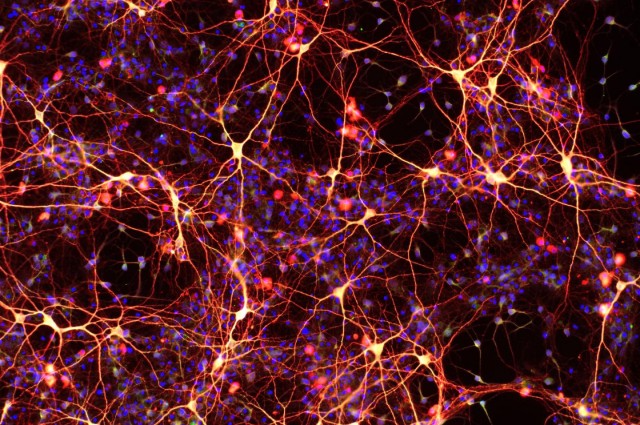“This method brings us closer to being able to generate new cells at the site of injury in patients,”

photo credit: Neurons made from reprogrammed mouse skin cells. Mingliang Zhang, PhD/Gladstone Institutes
Not only that, but in a separate study published by the same group, they have also managed to take mouse skin cells and turn them into brain cells using a similar technique.
The team of scientists, led by Sheng Ding at the Gladstone Institute of Cardiovascular Disease in San Francisco, hope that their research could one day aid in the regeneration of tissue at the site of damage, such as in patients who have suffered cardiac arrest.
Using a mixture of different drugs to coax cells already present to turn into fully functioning heart cells, for example, they could bypass the need to genetically engineer cells taken from the patient to achieve the same results. This would be a major step in treating tissue damage, the author’s claim, and is similar to how other animals such as salamanders achieve this naturally.

Only nine chemicals were needed to transform the skin cells into neurons. Mingliang Zhang, PhD/Gladstone Institutes
“This method brings us closer to being able to generate new cells at the site of injury in patients,” explains Ding, senior author on the two studies published this week, in a statement. “Our hope is to one day treat diseases like heart failure or Parkinson’s disease with drugs that help the heart and brain regenerate damaged areas from their own existing tissue cells. This process is much closer to the natural regeneration that happens in animals like newts and salamanders, which has long fascinated us.”
Previous studies have also been able to turn skin cells into other cell types, such as earlier work transforming them into neurons. But the researchers claim that their new technique is more efficient and reliable, and that they avoid the necessity to introduce new genes to the samples to get them to turn into stem cells, which would therefore avoid any concerns people might have about genetic engineering.
The first paper, published in Science, discusses transforming human skin cells into heart muscle cells. This was achieved by placing the original cells into a cocktail of nine chemicals to turn off the skin cell genes, and then a second cocktail of chemicals and growth hormones turned them into heart cells. An impressive 97 percent of the cells started beating. The researchers were even able to transplant newly transformed cells into mouse hearts, where they fully developed into healthy muscle cells in situ.
The brain cells were created in a similar way, with these results instead published in Cell Stem Cell. Over 10 days, the researchers were able to turn the mouse skin cell genes off, and when transplanted into a mouse brain, they went on to form the three main brain cell types: neurons, oligodendrocytes, and astrocytes. This, the researchers claim, gives hope that perhaps someday brain injuries and neurological conditions such as Parkinson’s could potentially be treated with similar neural stem cells that could self-replicate and heal the injury.

































Leave a Comment
You must be logged in to post a comment.